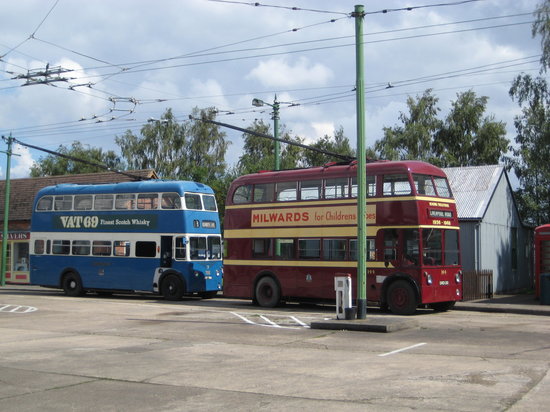


The Trolleybus Museum at Sandtoft is a transport museum which specialises in the preservation of trolleybuses. It is located by the village of Sandtoft, near Belton on the Isle of Axholme in the English county of Lincolnshire.
Located between Doncaster and Scunthorpe, the Trolleybus Museum at Sandtoft has over 60 historic trolleybuses in its collection. Many are in working order and on open days visitors can ride on them.
Most of our trolleybuses come from towns and cities around Britain, and we show some of the social history of their heyday - the 1940's through to 1960's. We also have a few important examples from around Europe, Canada and New Zealand.
To complement the trolleybuses, the Museum has a number of other historic vehicles, many of them diesel buses.
What is a trolleybus?
Trolleybuses are electrically-operated, drawing 550 volts DC mains electricity from specially constructed overhead wiring. They run on rubber tyres, like normal buses, but are emission-free.
The Museum offers a fascinating day out for all the family. It is open on specific open days only between April and November (we call these “Trolleydays”) when visitors can ride on some of our trolleybuses.
There are many other things to see and do, whether or not you like trolleybuses and transport.
The Trolleybus Museum at Sandtoft commissioned a full-size working replica of a pioneer 1911 trolleybus.
We can now tell another chapter about the history of the trolleybus - why not take a ride and find out what it was like over 100 years ago to ride on a solid-tyred, wooden-seated “trackless trolley”?
Accessibility
We welcome vistors with disabilities and much of the Museum is accessible to people with disabilities, although there may be wheelchair access problems in certain areas.
the policy of the Trolleybus Museum at Sandtoft to promote access for all with regard to the Museum’s facilities and attractions as far as that is possible. Where full access is not possible - for example, most of our historic trolleybuses and diesel buses were not designed with people with mobility problems in mind - our staff will offer assistance to the best of their ability.
Parking
Designated disabled parking spaces are provided as close to the Museum’s entrance building as possible. Please note that on our busier open days (e.g. Sandtoft Gathering Day) our normal car parking area is used for displays, so car parking will be further away from the entrance than normal. All car parking is free.
Dogs
Guide and assistance dogs are welcome throughout the Museum.
Other dogs are welcome but must be kept on a short lead and aren't allowed in the Tea Trolley Cafe and the Trolleyshop. Dogs can ride on trolleybuses and motorbuses at the conductor's discretion, provided they are well-behaved and don't cause annoyance to other passengers - dogs aren't allowed on seats though.
Wheelchair and mobility scooters
Ramps are provided wherever necessary to give access to buildings, and at road crossing points, but due care should be taken when negotiating road crossing points. Many walkways are hard-surfaced, but some (notably the nature trail) are not; there are also considerable areas of grass that may be used for vehicle and other displays: these paths and grassed areas are normally firm but users of wheelchairs or mobility scooters should assess for themselves whether to venture onto them!
Wheelchair access may be restricted in the main trolleybus depot building as this is not intended as an exhibition hall; vehicles may be parked close together and wheelchair access between them will therefore not be possible.
We cannot carry wheelchairs on our historic trolleybuses and diesel buses as these vehicles were not designed with accessibility in mind.
A wheelchair is available in the entrance building should you need one.
Walking
Ramps are provided wherever necessary to give access to buildings and at road crossing points. Walking distances are not great but people with mobility problems may find some of the terrain on direct routes unsuitable. Many walkways are hard-surfaced, but some (notably the nature trail) are not; there are also large areas of grass that may be used for vehicle and other displays.
Accessible (disabled person’s) toilet
A good-sized and properly-equipped disabled person’s toilet room is provided. For visitors with special needs, it is fitted with a fully adjustable changing bench.
Parent and baby room
A dedicated parent and baby room is available for nappy changing and feeding babies.
Café, allergies and special dietary needs
Our café has a 5*-rated hygiene certificate and staff have been appropriately trained. If you have any allergies or dietary needs and need to know what ingredients have gone into a particular item, please ask.
Historic trolleybuses and diesel buses
Please note that trolleybuses are generally very quiet in operation, so please take extra care when crossing roadways - please use designated crossing places – and do not rely on expecting to hear vehicles approaching. For your personal safety, please also keep to designated walkways and footways.
Most of our historic trolleybuses and diesel buses were designed and constructed at a time when no consideration was given to accessibility, so there may be problems for visitors with impaired mobility in boarding and alighting from our historic trolleybuses and motorbuses. There is no wheelchair access to the interiors of our historic trolleybuses and motorbuses. Our friendly staff will make every effort to assist with boarding and alighting from our trolleybuses and motorbuses and we have portable steps available.
Safety
Visitors are asked, for safety reasons, to not enter (or allow their children or other charges to enter) driver’s cabs or board any of the vehicles that are on static display or in our storage building without being invited to do so by a Museum official.
Visitors with special needs
The Trolleybus Museum offers a good environment for a whole range of visitors, so we are happy to welcome visitors with various sorts of disabilities, difficulties and special needs. Our concession rate entrance charge includes visitors who are registered disabled and their carer(s). Of note for when planning visits for visitors with special needs is that the accessible toilet facility is equipped with an adjustable changing bench.

